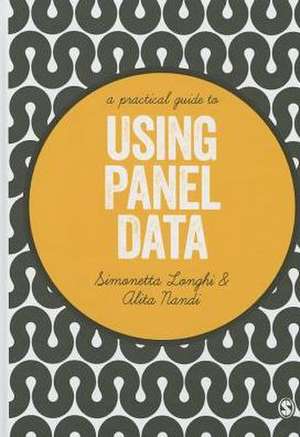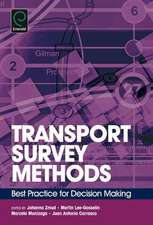A Practical Guide to Using Panel Data
Autor Simonetta Longhi, Alita Nandien Limba Engleză Paperback – 8 dec 2014
It describes the different types of panel datasets commonly used for empirical analysis, and how to use them for cross sectional, panel, and event history analysis. Longhi and Nandi then guide the reader through the data management and estimation process, including the interpretation of the results and the preparation of the final output tables.
Using existing data sets and structured as hands-on exercises, each chapter engages with practical issues associated with using data in research. These include:
- Data cleaning
- Data preparation
- Computation of descriptive statistics
- Using sample weights
- Choosing and implementing the right estimator
- Interpreting results
- Preparing final output tables
- Graphical representation
| Toate formatele și edițiile | Preț | Express |
|---|---|---|
| Paperback (1) | 465.42 lei 6-8 săpt. | |
| SAGE Publications – 8 dec 2014 | 465.42 lei 6-8 săpt. | |
| Hardback (1) | 958.19 lei 6-8 săpt. | |
| SAGE Publications – 8 dec 2014 | 958.19 lei 6-8 săpt. |
Preț: 465.42 lei
Nou
Puncte Express: 698
Preț estimativ în valută:
89.06€ • 95.23$ • 74.25£
89.06€ • 95.23$ • 74.25£
Carte tipărită la comandă
Livrare economică 18 aprilie-02 mai
Preluare comenzi: 021 569.72.76
Specificații
ISBN-13: 9781446210871
ISBN-10: 1446210871
Pagini: 344
Dimensiuni: 170 x 242 x 18 mm
Greutate: 0.59 kg
Ediția:1
Editura: SAGE Publications
Colecția Sage Publications Ltd
Locul publicării:London, United Kingdom
ISBN-10: 1446210871
Pagini: 344
Dimensiuni: 170 x 242 x 18 mm
Greutate: 0.59 kg
Ediția:1
Editura: SAGE Publications
Colecția Sage Publications Ltd
Locul publicării:London, United Kingdom
Recenzii
This book is exactly what I have been looking for in my teaching, as a valuable guide for graduate and advanced undergraduate students who are thinking of tackling panel data but feel overwhelmed by how complicated it seems compared to working with standard cross-sectional datasets. The authors nicely combine discussion of general statistical principles with lots of example Stata code demonstrating many types of analysis. Critically, the book tells students and researchers not only how to carry out analysis but shows how to prepare and manage panel data.
This is a unique and refreshing resource in the field of panel data analysis of individuals and households. The book takes the reader by the hand and covers the whole of the research process. In doing so, it provides solutions to very relevant issues faced by longitudinal research practitioners in their day-to-day work lives, striking a fine balance between substantive and practical advice. A must have for researchers, instructors and students interested in the analysis of household panel datasets.
This is an excellent practical guide to carrying out analysis of individual level panel surveys. Providing the reader with everything they need to know and written with exemplary clarity, it works through issues and approaches in a logical way yet without oversimplifying. I would recommend anyone contemplating analysis of a panel study, whether for an MSc dissertation, a PhD or an academic experienced with cross-sectional data to read – and use - it.
Simonetta Longhi and Alita Nandi’s book is a clear and comprehensive guide to panel data in all its complexity. It is a must for any researcher interested in using one of the household longitudinal studies The book is full of useful advice with abundant examples of Stata programs and techniques. I will be recommending it to colleagues and students alike.
This volume is a fantastic addition to the growing social science literature on aspects of quantitative data analysis and should feature on the reading list for any post graduate statistics course in the social sciences. This will be a prerequisite wherever the analysis of panel data is taught for many years.
This is a unique and refreshing resource in the field of panel data analysis of individuals and households. The book takes the reader by the hand and covers the whole of the research process. In doing so, it provides solutions to very relevant issues faced by longitudinal research practitioners in their day-to-day work lives, striking a fine balance between substantive and practical advice. A must have for researchers, instructors and students interested in the analysis of household panel datasets.
This is an excellent practical guide to carrying out analysis of individual level panel surveys. Providing the reader with everything they need to know and written with exemplary clarity, it works through issues and approaches in a logical way yet without oversimplifying. I would recommend anyone contemplating analysis of a panel study, whether for an MSc dissertation, a PhD or an academic experienced with cross-sectional data to read – and use - it.
Simonetta Longhi and Alita Nandi’s book is a clear and comprehensive guide to panel data in all its complexity. It is a must for any researcher interested in using one of the household longitudinal studies The book is full of useful advice with abundant examples of Stata programs and techniques. I will be recommending it to colleagues and students alike.
This volume is a fantastic addition to the growing social science literature on aspects of quantitative data analysis and should feature on the reading list for any post graduate statistics course in the social sciences. This will be a prerequisite wherever the analysis of panel data is taught for many years.
Cuprins
PART ONE: DATA PREPARATION IN MICRO PANEL SURVEYS
Why Panel Surveys
Different Types of Panel Surveys
A First Look at the Data Using Stata
Preparing the Data for Longitudinal Analysis
Working with Multiple Datasets
Identifying Household Members and Matching Information of Spouses and Partners
PART TWO: ANALYSIS OF CROSS-SECTION AND PANEL DATA
Sample Design, Non-response and Weights
Analysis of Cross-Section Data
Analysis of Panel Data for Continuous Dependent Variables
Analysis of Panel Data for Discrete Dependent Variables
PART THREE: EVENT HISTORY: DATA PREPARATION AND ANALYSIS
Introduction to Duration Analysis
How to Use Retrospective History Data Files: an Example
Analysis of Event History Data
PART FOUR: PRESENTING YOUR RESULTS
Producing Output Tables and Graphs
Why Panel Surveys
Different Types of Panel Surveys
A First Look at the Data Using Stata
Preparing the Data for Longitudinal Analysis
Working with Multiple Datasets
Identifying Household Members and Matching Information of Spouses and Partners
PART TWO: ANALYSIS OF CROSS-SECTION AND PANEL DATA
Sample Design, Non-response and Weights
Analysis of Cross-Section Data
Analysis of Panel Data for Continuous Dependent Variables
Analysis of Panel Data for Discrete Dependent Variables
PART THREE: EVENT HISTORY: DATA PREPARATION AND ANALYSIS
Introduction to Duration Analysis
How to Use Retrospective History Data Files: an Example
Analysis of Event History Data
PART FOUR: PRESENTING YOUR RESULTS
Producing Output Tables and Graphs
Notă biografică
Descriere
Each chapter in this introduction features existing data sets and hands-on exercises to present readers with all the practical tools needed to successfully use panel data in their research






